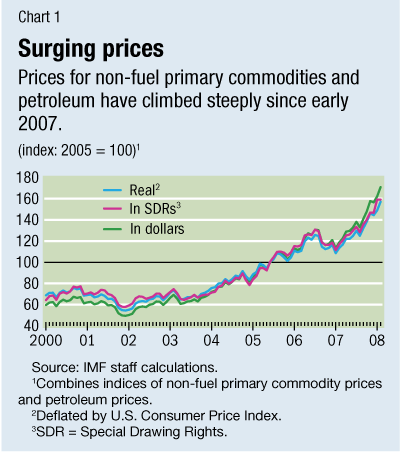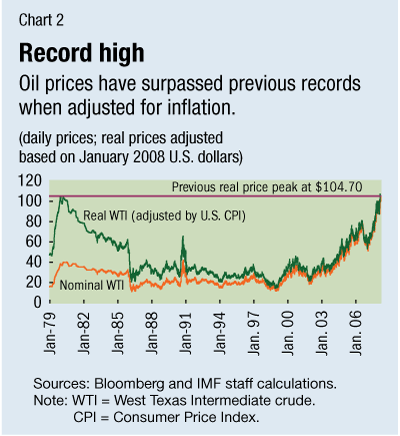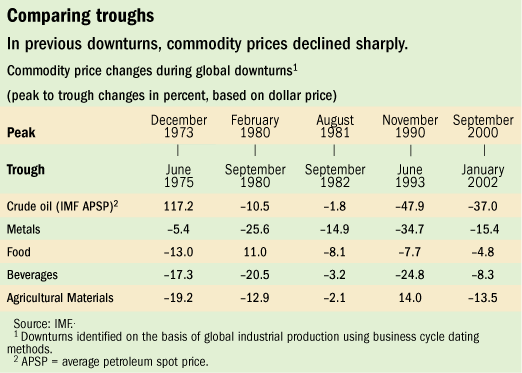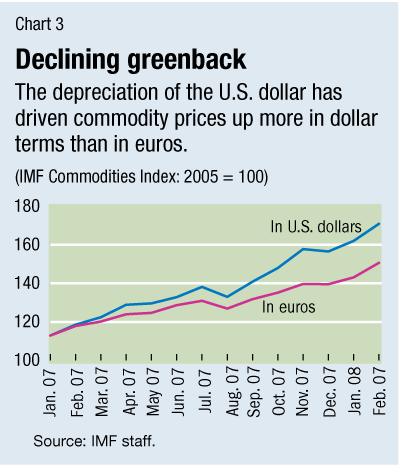
Typical street scene in Santa Ana, El Salvador. (Photo: iStock)
IMF Survey: Commodity Price Moves and the Global Economic Slowdown
March 20, 2008
- Rising commodity prices causing inflationary pressures
- Price spikes in 2008 largely due to financial factors
- Global economic slowdown may lead to easing of commodity prices
Commodity prices have continued their rapid ascent this year, with oil leading the uptrend.

Commodities are both consumed and used as inputs in the production of other goods, and are financial assets (photo: Diego Guidice/KRT)
IMF analysis
The IMF's commodity price index has risen by a cumulative 10 percent in 2008 after having already increased by about 30 percent between December 2006 and December 2007 (see Chart 1).
Although further price increases for some commodities, such as wheat and tin, were not surprising in view of supply shocks, the strong increase in prices of other commodities was more unexpected.

In particular, oil prices surged from around $90 a barrel in late January 2008 to over $105 a barrel by mid-March, surpassing their previous record high in constant prices set on December 17, 1979 (see Chart 2). Base metal prices rebounded after falling during the second half of 2007.

Apparent disconnect
Against the backdrop of intensifying credit market problems and slowing growth in advanced economies, the current strength of commodity prices is puzzling to some analysts. In all recent global downturns, commodity prices declined sharply (see table), suggesting a disconnect between commodity prices and the ongoing slowdown of the global economy.
Much of the apparent disconnect reflects the fact that emerging and developing economies, which have been responsible for the bulk of recent commodity demand growth, have so far been less affected by the slowing growth in advanced economies. More recently, the price momentum was reinforced by financial factors.

The resilience of high commodity prices will depend on the extent of spillovers of slowing growth in advanced economies to the rest of the world.
The financial side of commodity markets
Recent commodity market developments have highlighted the dual nature of commodities. They are goods that are both consumed and used as inputs in the production of other goods, and financial assets (to the extent that they can be bought and sold and used as a store of value).
In recent months, the financial side has come to the fore. In particular, the constellation of U.S. dollar depreciation and falling short-term real interest rates has pushed up commodity prices through a number of channels, including by enhancing the attractiveness of commodities as an alternative asset (see also Chart 3). This is particularly true of gold prices, which have surged to record-high real levels.

More generally, with high returns from booming prices that have not been strongly correlated with returns on other asset classes, commodities have increasingly been used for portfolio diversification. This trend has been reflected in rising inflows into commodity funds and assets. Overall, these financial factors seem to explain a large part of the increase in crude oil prices so far in 2008, as well as the rising prices of other commodities.
Attractiveness of commodity assets
The attractiveness of commodities as financial assets must be seen against the backdrop of continued tight market balances—that is, strong net demand for commodities (consumption minus production) amid low inventories and, in the case of nonrenewable resources, low spare capacity. As discussed in more detail in the March edition of Finance & Development ("Riding a Wave"), market tightness is underpinned by a number of factors.
• Rapid growth in emerging economies fuels demand. Incoming data on commodity demand underline continued strength from emerging economies. These economies have accounted for virtually all of the demand growth over the past few years, reflecting the greater commodity intensity of their economies compared with advanced economies. Going forward, many market participants expect commodity demand to continue to expand robustly, given the strong momentum in emerging economies.
• Food demand is boosted by biofuel production. Half of the increase in global corn consumption in 2007 was related to ethanol production, and the recent U.S. Energy Bill will ensure continued increases in demand from this source. This has already led to some spillovers on prices of other food commodities through higher feed costs, crop substitution, and demand substitution, and further spillovers are likely.
• Sluggish supply response to higher prices. Sustained demand growth has increasingly pushed supply up against capacity limits, as global supply has responded slowly to rising prices. For oil, demand has caught up with capacity after decades of substantial spare capacity, and problems in supply adjustment are now expected to be long lasting. Capacity expansion has been held back by escalating costs, reflecting geological and technological constraints that have boosted average costs of production in marginal fields. In addition, policy-related restrictions--including sharply higher royalties and taxes—have limited production growth, while shortages in skilled labor and specialized equipment have raised investment costs. The supply response to the large and persistent increase in biofuel demand will likely lead to a more gradual price increase than in the past, when higher food prices were driven primarily by short-term supply problems (for example, because of bad weather conditions). For metals and minerals, infrastructure bottlenecks have hampered rapid capacity expansion.
Impact of high commodity prices
Rising commodity prices have led to pressures on inflation. The inflation impact of food price increases is of particular concern, especially for emerging and developing economies, because the corresponding expenditure shares exceed those of oil-related spending by a substantial margin. Rising fuel and food prices have boosted headline inflation in many countries, and the impact on headline inflation will persist through much of 2008 even without further increases in the prices of the underlying commodities. Risks are that the impact higher fuel and food prices could feed into inflation expectations, which may lead to second-round effects on inflation, thereby constraining monetary policy at a time of intensified spillovers from slowing growth in advanced economies.
Rising commodity prices also increase cost pressures on producers and reduce household purchasing power in commodity-importing countries. These effects amplify the downdraft from the credit market crisis on consumers in advanced economies. At the global level, the effect of these subtractions from aggregate demand is unlikely to be fully offset by higher expenditure in commodity-exporting countries in response to the substantial terms of trade gains.
Rising commodity prices, especially of food items, have posed an increasing burden on the poor in emerging and developing economies. In those countries, the food-related expenditure of the poor is much larger as a share of household expenditure than for other income groups.
To relieve social pressures from rising food prices, a growing number of countries have resorted to reducing import barriers and increasing export taxes in an effort to maintain adequate domestic food supplies, thereby contributing to global market tightness. Others have instituted subsidies that reduce the price pass-through, in some cases at considerable fiscal cost. Instead, the main policy instrument, whenever possible, should be well-targeted cash transfers.
Commodity price prospects
With global growth widely expected to decline in 2008-09, commodity demand will likely soften. As a result, prices of most commodities should eventually start easing.
Unless there is a substantial global downturn, however, the extent of easing may be small, given the current tight balances in some commodity markets.
Comments on this article should be sent to imfsurvey@imf.org


